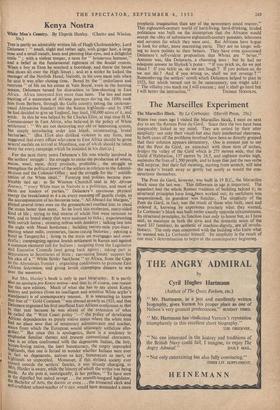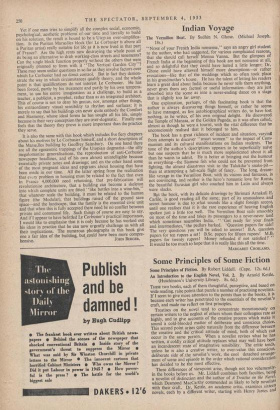The Marseilles Experiment
The Marseilles Block. By Le Corbusier. (Harvill Press. 21s.)
WHEN two years ago I visited the Marseilles block, I went on next day to see the.Roman Pont du Gard. Since then the two have been inseparably linked in my mind. They are united by their utter simplicity: not only their visual but also their intellectual sheerness. In both cases all the problems involved have been so directly grasped that their solution appears elementary. One is content just to say that the Pont du Gard, an aqueduct with three tiers of arches, bridges the valley of the Gard which is 275 metres wide, that the Unite d'Habitation, 137 metres by 24.5, and eighteen stories high, maintains the lives of 1,500 people, and to hope that just the two verbs will surprise, that their full meaning, starting from scratch, will take the reader's breath away as gently but surely as would the con- structions themselves.
The Pont du Gard, however, was built in 19 B.C., the Marseilles block since the last war. This difference in age is important. The aqueduct had the whole Roman tradition of building behind it; its 'structural principles have longebeen worked out; its usefulness was unquestioned; its grandeur was familiar. The simplicity of the Pont du Gard, in fact, was the result of those who built, used and ordered it, knowing by experience precisely what they wanted. Le Corbusier's block was built under exactly opposite ciPeumstances. Its structural principles, its function (not only to house but, as I have said, to maintain in both the civic and the domestic sense of the word 337 families), its aesthetic of machine-dignity, are all revolu- tionary. The only man concerned with the building who knew what he wanted was Le Corbusier himself. Its simplicity is the result of one man's determination to begin at the contemporary beginniikg.
Yet if one man tries to simplify all the complex social, economic, psycholoecal, aesthetic problems of-our time and literally to build on his solution, the result is bound to be a Utop.an over-simplifica- tion. Is the Puritan Marseilles block (for Le Corbusier is above all a Puritan artist) really suitable for life as it is now lived in that part of France? Are the high rents now destroying the whole point of its being an alternative to drab working-class streets and tenements? Can the single block function properly without the others that were originally planned to form with it "The Vertical Garden City"? These may seem unfair questions in so far as they involve factors over which Le Corbusier had no direct control. But in fact they demon- strate the way in which circumstances qualify theory, and the whole point is that qualifications do not interest Le Corbusier. He has been forced, partly by his treatment and partly by his own tempera- ment, to use his entire imagination as a challenge, to build as a teacher, a publicist, a prophet, rather than as an integrated architect. This of course is not to deny his genius, nor, amongst other things, his extraordinary visual sensibility to rhythm and surfaces; it is merely to say that his buildings can never quite embody the Comfort and Harmony, whose ideal forms he has sought all his life, simply because in their very conception they are over-dogmatic. Finally one feels that the theory they prove is more important than the practice they serve.
It is also the same with this book which includes five fiery chapters about his motives by Le Corbusier himself, and a short description of the Marseilles building by Geoffrey Sainsbury. On one hand there are all the egocentric trappings of the Utopian dogmatist—the silly megalomaniac generalisations, the reproduction of anti-Corbusier newspaper headlines, and of his own almost unintelligible because essentially private notes and drawings; and on the other hand some of the most pregnant ideas and epigrams about housing that have been made in our time. All the latter spring from the realisation that eNcry problem in housing must be related to the fact that even in France 4,000,000 need rehousing, that pre-fabrication will revolutionise architecture, that a building can become a skeleton into which complete units are fitted "like bottles into a wine-bin," that whatever scale the building, it must be related to the human figure (the Modular), that buildings raised off the ground save space—and the landscape, that the family is the essential civic unit and that when this is fully accepted there need be no conflict between private and communal life. Such things of course are easy to say. And if I appear to have belittled Le Corbusier's practical importance, I would like to emphasise that it is only because he has worked out his ideas in practice that he can now urgently challenge us with all their implications. The numerous photographs in this book give one a fair idea of the building, but could have been more compre- hensive. JOHN BERGER.



































 Previous page
Previous page